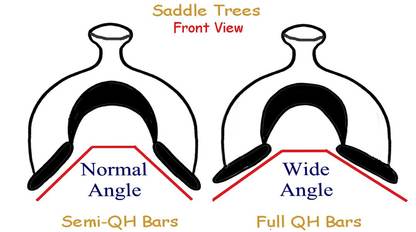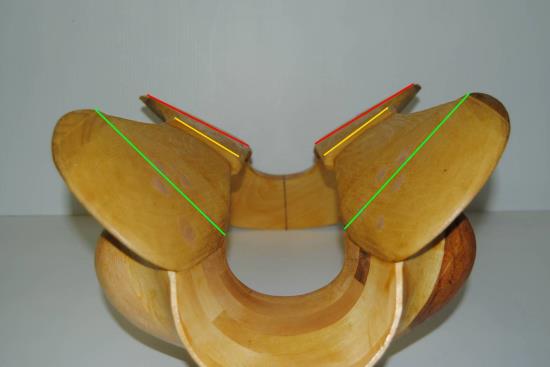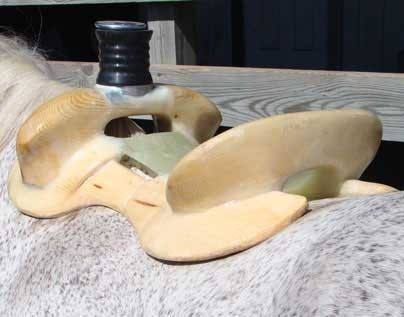Western saddle tree sizes… how do you determine them? Horses have different back shapes and sizes. If you’re planning on participating in any Western riding discipline, you’ll need to understand the importance of Western saddle tree sizes, how to determine whether the tree will fit your horse, and how Western saddle tree sizes affect your horse’s ability to perform.
Western Saddle Tree Sizes – Does Your Saddle Pinch?
If you buy a saddle that pinches a horse’s shoulders or presses on his withers, this can have very negative effects on the horse and how you ride.
Your horse will be in pain, and he may not let you mount him because you have the wrong tree size, and it’s probably digging into his shoulders.
So, saddle tree size determines whether you have a good fit for your horse and whether your horse will be comfortable with you riding on him.
Western Saddle Tree Sizes – Are There Standard Guidelines?
The horse saddle industry doesn’t have standard guidelines that designate Western tree saddle sizes. However, there are several methods you can use to closely approximate the size of your saddle’s tree.
Western Saddle Tree Sizes – How to Measure Western Saddle Tree Sizes
Here are some things to look for when trying to measure Western saddle tree sizes to match your particular horse. Whether your horse has a narrow or wide back, you should follow the below guidelines.
Examine The Angle of the Bars
The angle of the bars, as they come down the gullet, determines your saddle tree size. For example, the greater the angle of the bars, the wider the tree. What kind of horses use wide trees?
Broad-backed, mutton withered horses will need wider trees.
Bars Have Different Angles
The bar angle is comparable to the pitch on a barn’s roof. You have some angles that are steep and narrow, while others are flat.
The ideal angle for the bar, when viewed from the front of the horse, should match the slope of the area just behind the horse’s shoulder. This area is known as the “saddle pocket.”
Bar Twist
The change of the bar angle from front to back as it follows the contours from just behind your horse’s shoulder toward his croup is referred to as the bar twist.
If the bar angle and twist match perfectly to your horse’s back, chances are everything els will fit as well.
How Much Flare Do The Bars Have
The bar tips (usually in the front) where they curve upward and away from your horse’s shoulders is referred to as bar flare. Some trees offer a little flare in the back as well to allow for a high-croup horse.
Bar Curve, Rock, or Sweep
The amount of curve in the bars from front to back is referred to as the bar curvature, rock or sweep. Some horses need a tree with a little curve, while others need lots of curve.
What kind of horse needs a tree with very little curve? A horse with a flat topline.
However, a swayback horse, or one with a dip will need a tree with a lot of rock to it. Curvature of the tree is crucial to the fit of the saddle. Putting a flat tree on a horse with a sway back makes no sense.
Likewise, you wouldn’t want to put a curved tree on a horse with a flatter back. Neither of these scenarios make for a happy horse.
Narrow Bar Angle
In general, a saddle with a normal or narrow bar angle is considered as having a regular or semi-quarter horse bars. The exact measurement of these bars will be an angle of 86 degrees, plus or minus 3 degrees in either direction.
Wide Tree
A saddle that has full quarter horse bars, also known as a wide tree, generally has a measurement of 90 degrees, plus or minus 3. A very wide tree will have an angle of 94 degrees plus or minus 3.
Very wide trees are often used on large horses such as drafts.
Contact the Manufacturer if You Can
When all else fails, the best and easiest way to determine Western saddle tree sizes is to contact the manufacturer of the saddle and asking them.
A high-quality saddle will have the manufacturer’s lable and serial number stamped on a plate located on the saddle. It could also be found on the stirrup strap. Once you’ve contacted the manufacturer, ask them to look up your saddle tree size.
For more information on Western tree saddle sizes visit The Horse Saddle Shop.
Did you find this helpful? I’d love to hear your feedback.




Shalisha,
Great information! I could imagine it’s really important to have a good fitting saddle, especially since riding can be hard on the butt if it’s the wrong size. I knew from your previous articles that there’s a lot that goes into saddles that most people don’t know about. I’m sharing this with my family that has horses in the lower states since in Alaska I don’t have any horses. But I do love to visit my family that does.
Thanks for sharing this! Great information!
Katrina
Hi Katrina. Thank you so much for stopping by and commenting. I always appreciate when people pass on useful information to others. Thanks again.
Hi Shalisha,
Such an informative and interesting article I must say, it gave a clear idea to readers about the different sizes of saddles which I’m sure many didn’t know about it.
Saddles aren’t just for comfort while riding but they act as the intermediary between rider and horse, made me realize saddle should be a perfect fit for the horse because saddle hinders horse performance.
Saddle panels sit on either side of the horse’s spine and on the muscles proper fit is essential. I love how you illustrated it with help of diagrams and videos. Clearly explained the angles of bars, the gullet determines the size of the saddle, how the bar curve, rock, sweep, narrow, and wide are analyzed. Keeping horses healthy is part of being a good rider and owner.
That is great content thank you.
Hi Samantha! Thank you for your thoughtful comment. Please stop by again.
Hi Shalisha,
Very helpful post on Western Saddle Tree sizes. As someone who has been curious about getting into horseback riding I’ve just started doing the preliminary research and have found there is an overwhelming amount of info out there. It’s dizzying! So with that, I thank you for writing such an easy to follow and informative post. I look forward to browsing the rest of your website for more info!
Hi Dev! Thanks for stopping by and commenting. The goal of my site is to provide good information so that horseback riders can make informed decisions. I’m glad this post was helpful to you. Hope to see you soon.
Simple and to the point. I love the use of diagrams as well. Excellent use of the video too. I’ve always wanted to own horses, so maybe one day I’ll be able to put this information to use.
Is the material of the saddle important as well? Do different horses require different materials? All I know of is leather and whatever metal is used, though I’m sure there’s far more to it, haha.
Hi Christina. Thanks for your questions. The materials are very important insofar as what materials the tree of the saddle is made of. Your tree needs to be strong since it’s the foundation of the saddle. You wouldn’t want your saddle to splint or crack under any circumstance because it will dig into your horse’s back causing injury. But it’s also important that your saddle is made from quality material, especially if you’re engaged in a discipline that requires roping, barrel racing, or any other rigorous riding. And no, different horses don’t require different materials. But all horses need a quality saddle. I hope this helps.
Well, Shalisha, I must admit that your article provided me with answers I’ve been having regarding horse riding and proper saddling. I also watched the video you provided and the article, and both of them were very helpful. When I grew up, I dream of being a jockey one day, and now this post has brought back those memories. Anyway, thanks for sharing this important post about proper horse saddling.
Hi Kokontala. Thanks for your feedback. I’m glad you got a lot out of my post. I added the video because sometimes people like listening and watching videos more than they do reading.
Interesting and informative article. Before reading your article, my mindset has been that the saddle must be comfortable to the rider. However, your article let me realize that more than this, it is most important to make sure that the saddle has to be perfect for the horse as that affects his ability to perform. So easy to take this for granted. Thank you for an enlightening post.
Hi there! Thanks for stopping by and commenting. Yes, I’m glad my article helped you realize that there’s more to saddle fit than the rider’s comfort.
Hi Salisha. Thank you for publishing this article. I knew that there were different sizes of saddles, but I didn’t realize how much detail goes in to selecting and sizing the proper saddle tree for the horse. It is obvious to me that you are very knowledgeable about horses and your article is very detailed and informative. Thanks again for publishing it!
Hi Tom. I’m so glad you found my article helpful. Yes, a lot of detail goes into making Western saddles.